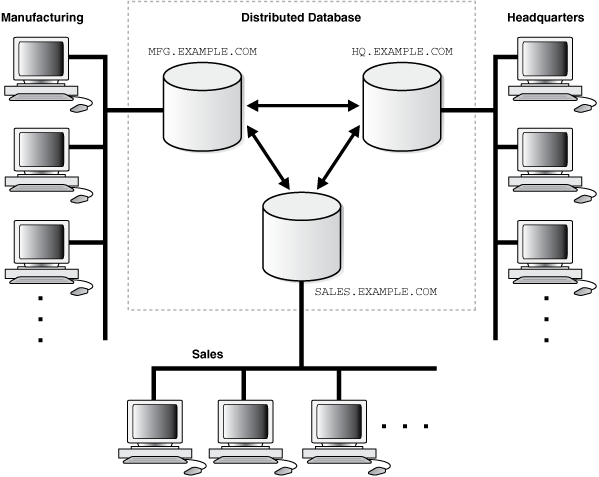A distributed database system allows applications to access data from local and remote databases. In a homogenous distributed database system, each database is an Oracle Database. In a heterogeneous distributed database system, at least one of the databases is not an Oracle Database. Distributed databases use a client/server architecture to process information requests.
- Homogenous Distributed Database Systems
A homogenous distributed database system includes only Oracle databases. - Heterogeneous Distributed Database Systems
A heterogeneous distributed database system includes both Oracle databases and non-Oracle databases. - Client/Server Database Architecture
A database server is the Oracle software managing a database, and a client is an application that requests information from a server. Each computer in a network is a node that can host one or more databases. Each node in a distributed database system can act as a client, a server, or both, depending on the situation.
Parent topic: Distributed Database Concepts
30.1.1 Homogenous Distributed Database Systems
A homogenous distributed database system includes only Oracle databases.
- About Homogenous Distributed Database Systems
A homogenous distributed database system is a network of two or more Oracle Databases that reside on one or more systems. - Distributed Databases Versus Distributed Processing
The terms distributed database and distributed processing are closely related, yet have distinct meanings. - Distributed Databases Versus Replicated Databases
The terms distributed database system and database replication are related, yet distinct.
Parent topic: Distributed Database Architecture
30.1.1.1 About Homogenous Distributed Database Systems
A homogenous distributed database system is a network of two or more Oracle Databases that reside on one or more systems.
Figure 30-1 illustrates a distributed system that connects three databases: hq, mfg, and sales. An application can simultaneously access or modify the data in several databases in a single distributed environment. For example, a single query from a Manufacturing client on local database mfg can retrieve joined data from the products table on the local database and the dept table on the remote hq database.
For a client application, the location and platform of the databases are transparent. You can also create synonyms for remote objects in the distributed system so that users can access them with the same syntax as local objects. For example, if you are connected to database mfg but want to access data on database hq, creating a synonym on mfg for the remote dept table enables you to issue this query:
SELECT * FROM dept;
复制
In this way, a distributed system gives the appearance of native data access. Users on mfg do not have to know that the data they access resides on remote databases.
Figure 30-1 Homogeneous Distributed Database

Description of "Figure 30-1 Homogeneous Distributed Database"
An Oracle Database distributed database system can incorporate Oracle Databases of different releases. All supported releases of Oracle Database can participate in a distributed database system. Nevertheless, the applications that work with the distributed database must understand the functionality that is available at each node in the system. A distributed database application cannot expect an Oracle7 database to understand the SQL extensions that are only available with Oracle Database.
Parent topic: Homogenous Distributed Database Systems
30.1.1.2 Distributed Databases Versus Distributed Processing
The terms distributed database and distributed processing are closely related, yet have distinct meanings.
There definitions are as follows:
Distributed database
A set of databases in a distributed system that can appear to applications as a single data source.
Distributed processing
The operations that occurs when an application distributes its tasks among different computers in a network. For example, a database application typically distributes front-end presentation tasks to client computers and allows a back-end database server to manage shared access to a database. Consequently, a distributed database application processing system is more commonly referred to as a client/server database application system.
Distributed database systems employ a distributed processing architecture. For example, an Oracle Database server acts as a client when it requests data that another Oracle Database server manages.
Parent topic: Homogenous Distributed Database Systems
30.1.1.3 Distributed Databases Versus Replicated Databases
The terms distributed database system and database replication are related, yet distinct.
In a pure (that is, not replicated) distributed database, the system manages a single copy of all data and supporting database objects. Typically, distributed database applications use distributed transactions to access both local and remote data and modify the global database in real-time.
Note:
This book discusses only pure distributed databases.
The term replication refers to the operation of copying and maintaining database objects in multiple databases belonging to a distributed system. While replication relies on distributed database technology, database replication offers applications benefits that are not possible within a pure distributed database environment.
Most commonly, replication is used to improve local database performance and protect the availability of applications because alternate data access options exist. For example, an application may normally access a local database rather than a remote server to minimize network traffic and achieve maximum performance. Furthermore, the application can continue to function if the local server experiences a failure, but other servers with replicated data remain accessible.
Parent topic: Homogenous Distributed Database Systems









